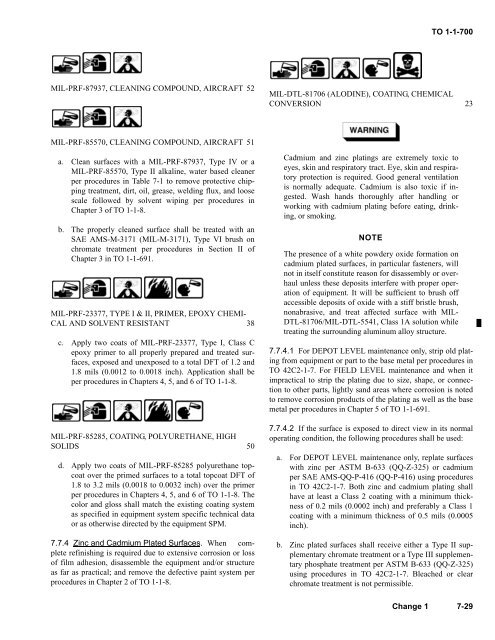TO 1-1-700 - Robins Air Force Base
TO 1-1-700 - Robins Air Force Base
TO 1-1-700 - Robins Air Force Base
You also want an ePaper? Increase the reach of your titles
YUMPU automatically turns print PDFs into web optimized ePapers that Google loves.
<strong>TO</strong> 1-1-<strong>700</strong><br />
MIL-PRF-87937, CLEANING COMPOUND, AIRCRAFT 52<br />
MIL-DTL-81706 (ALODINE), COATING, CHEMICAL<br />
CONVERSION 23<br />
MIL-PRF-85570, CLEANING COMPOUND, AIRCRAFT 51<br />
a. Clean surfaces with a MIL-PRF-87937, Type IV or a<br />
MIL-PRF-85570, Type II alkaline, water based cleaner<br />
per procedures in Table 7-1 to remove protective chipping<br />
treatment, dirt, oil, grease, welding flux, and loose<br />
scale followed by solvent wiping per procedures in<br />
Chapter 3 of <strong>TO</strong> 1-1-8.<br />
b. The properly cleaned surface shall be treated with an<br />
SAE AMS-M-3171 (MIL-M-3171), Type VI brush on<br />
chromate treatment per procedures in Section II of<br />
Chapter 3 in <strong>TO</strong> 1-1-691.<br />
MIL-PRF-23377, TYPE I & II, PRIMER, EPOXY CHEMI-<br />
CAL AND SOLVENT RESISTANT 38<br />
c. Apply two coats of MIL-PRF-23377, Type I, Class C<br />
epoxy primer to all properly prepared and treated surfaces,<br />
exposed and unexposed to a total DFT of 1.2 and<br />
1.8 mils (0.0012 to 0.0018 inch). Application shall be<br />
per procedures in Chapters 4, 5, and 6 of <strong>TO</strong> 1-1-8.<br />
MIL-PRF-85285, COATING, POLYURETHANE, HIGH<br />
SOLIDS 50<br />
d. Apply two coats of MIL-PRF-85285 polyurethane topcoat<br />
over the primed surfaces to a total topcoat DFT of<br />
1.8 to 3.2 mils (0.0018 to 0.0032 inch) over the primer<br />
per procedures in Chapters 4, 5, and 6 of <strong>TO</strong> 1-1-8. The<br />
color and gloss shall match the existing coating system<br />
as specified in equipment system specific technical data<br />
or as otherwise directed by the equipment SPM.<br />
7.7.4 Zinc and Cadmium Plated Surfaces. When complete<br />
refinishing is required due to extensive corrosion or loss<br />
of film adhesion, disassemble the equipment and/or structure<br />
as far as practical; and remove the defective paint system per<br />
procedures in Chapter 2 of <strong>TO</strong> 1-1-8.<br />
Cadmium and zinc platings are extremely toxic to<br />
eyes, skin and respiratory tract. Eye, skin and respiratory<br />
protection is required. Good general ventilation<br />
is normally adequate. Cadmium is also toxic if ingested.<br />
Wash hands thoroughly after handling or<br />
working with cadmium plating before eating, drinking,<br />
or smoking.<br />
NOTE<br />
The presence of a white powdery oxide formation on<br />
cadmium plated surfaces, in particular fasteners, will<br />
not in itself constitute reason for disassembly or overhaul<br />
unless these deposits interfere with proper operation<br />
of equipment. It will be sufficient to brush off<br />
accessible deposits of oxide with a stiff bristle brush,<br />
nonabrasive, and treat affected surface with MIL-<br />
DTL-81706/MIL-DTL-5541, Class 1A solution while<br />
treating the surrounding aluminum alloy structure.<br />
7.7.4.1 For DEPOT LEVEL maintenance only, strip old plating<br />
from equipment or part to the base metal per procedures in<br />
<strong>TO</strong> 42C2-1-7. For FIELD LEVEL maintenance and when it<br />
impractical to strip the plating due to size, shape, or connection<br />
to other parts, lightly sand areas where corrosion is noted<br />
to remove corrosion products of the plating as well as the base<br />
metal per procedures in Chapter 5 of <strong>TO</strong> 1-1-691.<br />
7.7.4.2 If the surface is exposed to direct view in its normal<br />
operating condition, the following procedures shall be used:<br />
a. For DEPOT LEVEL maintenance only, replate surfaces<br />
with zinc per ASTM B-633 (QQ-Z-325) or cadmium<br />
per SAE AMS-QQ-P-416 (QQ-P-416) using procedures<br />
in <strong>TO</strong> 42C2-1-7. Both zinc and cadmium plating shall<br />
have at least a Class 2 coating with a minimum thickness<br />
of 0.2 mils (0.0002 inch) and preferably a Class 1<br />
coating with a minimum thickness of 0.5 mils (0.0005<br />
inch).<br />
b. Zinc plated surfaces shall receive either a Type II supplementary<br />
chromate treatment or a Type III supplementary<br />
phosphate treatment per ASTM B-633 (QQ-Z-325)<br />
using procedures in <strong>TO</strong> 42C2-1-7. Bleached or clear<br />
chromate treatment is not permissible.<br />
Change 1 7-29
















